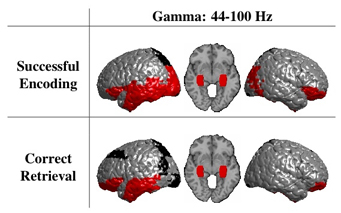Mental Detector
Psychologist Michael Kahana explains how brain waves can predict the veracity of human memories.
B. Davin StengelAnyone who’s bad with names knows that inaccurate, misremembered information can seem like the real thing. Not yet of practical assistance to those who regularly greet Joes as Johns or Joans as Joannes, Penn researchers have discovered a distinct pattern of brain waves that can predict the veracity of human memories. In the first study of its kind, neuroscientists in the Department of Psychology’s Computational Memory Lab analyzed recordings of brain activity from 52 neurosurgical patients being treated for drug-resistant epilepsy, looking for answers to two specific questions.
“The first question was, ‘Are there brain oscillations which, when you study an item, predict whether you’ll later remember that item?’” explains Michael Kahana, Professor of Psychology and Director of the Computational Memory Lab. “So if you see the word concert on a list, and you think about a concert, can I look inside your brain and take measurements that will predict whether you will later successfully recall that word on a delayed memory test?”
 |
| Brain oscillations associated with successful encoding are reinstated during correct retrieval. In this figure, areas with significant increases in activity are shown in red, and nonsignificant regions are shown in gray. Regions containing electrodes from fewer than five subjects are shown in black. |
Kahana and his team were able to show that there were specific high-frequency brain waves that signaled successful memory storage when subjects studied a particular item. These brain waves, known as gamma oscillations, appeared in regions of the brain determined in previous studies to be associated with episodic memory.
“Our second question was, ‘When you’re recalling words in delayed memory tests, can I look at the activity in your brain again and predict whether you will successfully recall the word concert, instead of incorrectly recalling the word symphony or music?’” says Kahana. “If you say, ‘I remember seeing the word music on the list,’ but music was never presented to you, then that memory is a distorted memory—or a false memory—even if it’s related to the true, target memory.”
Kahana and his team found that the same brain waves that signaled successful memory storage were active in the same regions of the brain during successful memory retrieval. The implications of their study, published in Psychological Science, could be far-reaching.
“Aside from the central question of trying to understand the amazing capacity of human memory, which in itself is a beautiful thing to try to uncover,” says Kahana, “it’s worth mentioning that the particular kind of memory that we study appears to be most diagnostic of neurological disorders. For example, recent work has shown that the type of memory pertinent to the gamma oscillation study is best predictive of people with mild cognitive impairment advancing to Alzheimer’s disease.”
Kahana is very interested in the potential clinical applications of his research. While no medical devices currently exist to help restore cognitive function to those with compromised memory due to conditions such as stroke or traumatic brain injury, Kahana imagines the development of neurocognitive prostheses that could assist people with memory impairment, or even help healthy individuals to improve their memory. He recently received a $300,000 three-year grant from the Dana Foundation to study the possibility of developing such devices.
“The major scientific frontier ahead of us is to understand how certain computational models of memory may actually be implemented in the human brain,” Kahana explains. “That’s why our collaborations with other departments and schools here at Penn are so important. In my lab, one doesn’t have to look far to find the selling points for the Penn Integrates Knowledge initiative across campus.”

